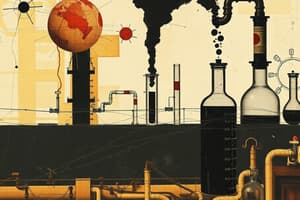Podcast
Questions and Answers
What is the primary reason why crude oil undergoes fractional distillation?
What is the primary reason why crude oil undergoes fractional distillation?
- To remove impurities from the crude oil.
- To separate the hydrocarbons based on their boiling points. (correct)
- To convert the crude oil into a more environmentally friendly fuel.
- To increase the density of the crude oil.
What type of hydrocarbon is most likely to condense near the bottom of a fractionating column?
What type of hydrocarbon is most likely to condense near the bottom of a fractionating column?
- Long-chain hydrocarbons with high boiling points (correct)
- Hydrocarbons with a high carbon-to-hydrogen ratio
- Hydrocarbons with a low carbon-to-hydrogen ratio
- Short-chain hydrocarbons with low boiling points
Which of the following statements is TRUE about the relationship between the length of a hydrocarbon chain and its boiling point?
Which of the following statements is TRUE about the relationship between the length of a hydrocarbon chain and its boiling point?
- Chain length has no effect on boiling point.
- Longer chains have lower boiling points than shorter chains.
- Longer chains have higher boiling points than shorter chains. (correct)
- The boiling point of a hydrocarbon is determined solely by its molecular weight, not chain length.
What is the main purpose of 'cracking' in the context of crude oil processing?
What is the main purpose of 'cracking' in the context of crude oil processing?
Which of the following is NOT directly produced as a result of fractional distillation of crude oil?
Which of the following is NOT directly produced as a result of fractional distillation of crude oil?
Flashcards
Crude Oil
Crude Oil
A fossil fuel formed from dead plants and animals, buried under mud.
Fractional Distillation
Fractional Distillation
A process that separates hydrocarbons based on their boiling points.
Hydrocarbons
Hydrocarbons
Compounds made of hydrogen and carbon; the main components of crude oil.
Boiling Points
Boiling Points
Signup and view all the flashcards
Cracking
Cracking
Signup and view all the flashcards
Study Notes
Crude Oil Formation and Properties
- Crude oil, also known as petroleum, is a fossil fuel.
- It's formed from the remains of dead plants and animals buried under mud over millions of years.
- Heat and pressure transform this organic matter into crude oil.
- Crude oil seeps into porous rocks underground.
- Crude oil is extracted by drilling.
Crude Oil Composition and Uses
- Crude oil is a mixture of hydrocarbons, mainly alkanes.
- It cannot be used directly as fuel.
- Fractional distillation separates crude oil into different fractions based on boiling points.
- This process creates useful fuels.
Fractional Distillation
- Crude oil is heated to become a gas.
- The hot gas rises through a fractionating column.
- Hydrocarbons with higher boiling points condense and collect at the bottom of the column (e.g., heavy fuel oil).
- Shorter chain hydrocarbons with lower boiling points condense higher up, producing useful fuels like diesel and petrol.
- Very short chains with very low boiling points remain as gases (e.g., liquefied petroleum gas).
Properties and Applications of Hydrocarbons
- Shorter chain hydrocarbons are highly flammable and excellent fuels.
- Longer chain hydrocarbons are used for other purposes or can be broken down into smaller ones via cracking.
Studying That Suits You
Use AI to generate personalized quizzes and flashcards to suit your learning preferences.




